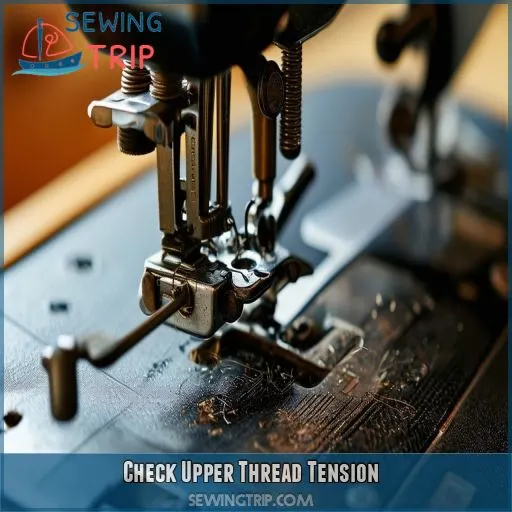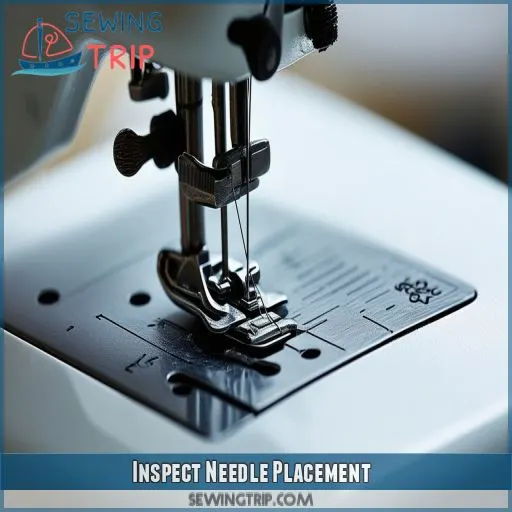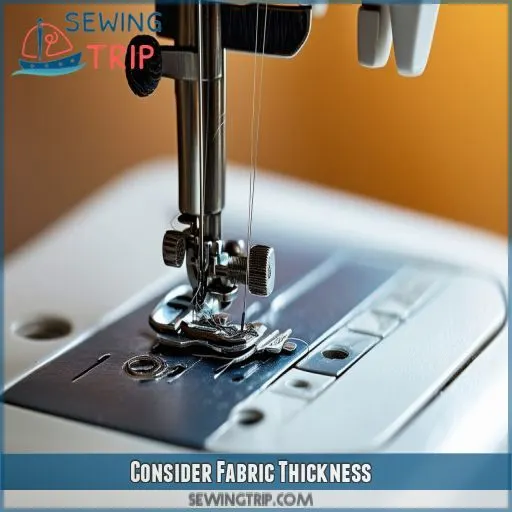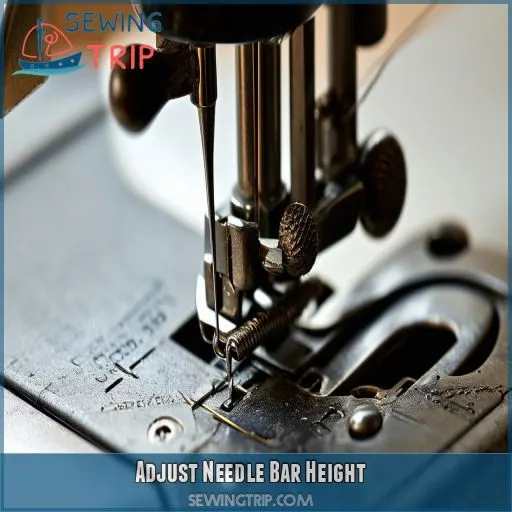This site is supported by our readers. We may earn a commission, at no cost to you, if you purchase through links.
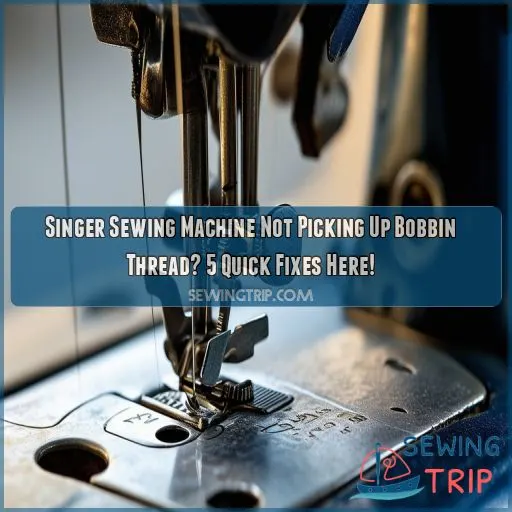
In this tutorial, find 5 quick fixes you can implement for this common problem. We look at tension adjustments, needle placement, inspecting the bobbin case, fabric considerations, and needle bar height.
Mastering these troubleshooting techniques will let you improve your sewing process and get your Singer back in action quickly.
Table Of Contents
Key Takeaways
- Threading troubles? Don’t throw in the towel! A quick check of your upper thread tension and proper threading can work wonders. Remember, sometimes it’s the little things that make the biggest difference – like making sure your thread is snugly seated in all the right places.
- Is your needle giving you the cold shoulder? Give it a once-over for any bends, burrs, or dull spots. A fresh, properly installed needle can be a real game-changer. It’s like giving your Singer a mini-makeover!
- bobbin case blues got you down? Time for some TLC! A clean, well-oiled bobbin case is the unsung hero of smooth sewing. Think of it as a spa day for your machine – a little pampering goes a long way.
- Thick fabrics making you sweat? Don’t panic! Adjusting your needle bar height might just be the secret sauce you need. It’s like finding the perfect dance partner for your fabric – when they’re in sync, magic happens!
Check Upper Thread Tension
First, check if your upper thread tension is too tight, as this can prevent the needle from picking up the bobbin thread. If needed, adjust the tension settings and rethread the upper thread correctly, ensuring it passes through all the guides and tension discs properly.
Adjust Tension Settings if Too Tight
Is your Singer sewing machine giving you tension headaches? Don’t fret! If your upper thread tension is too tight, it might be the culprit behind your bobbin thread woes. Here’s how to tackle it:
- Locate the tension dial on your machine’s front
- Turn the dial to a lower number for looser tension
- Test on a scrap fabric to find the sweet spot
- Adjust gradually to avoid overcorrecting
Rethread the Upper Thread Correctly
Proper tension means you have to rethread the upper thread in your Singer Sewing Machine. Raise the presser foot and threaded needle to their maximum height.
Guide the thread through each of the tension points, as marked on your machine’s diagram. Don’t skip any! The thread should glide within the tension discs but go easily through the take-up lever.
While actually threading the needle, pull gently on the thread to keep an even tautness for constant tension. Make sure the thread is positioned correctly in the threading seat in the tension knob.
A properly threaded upper way makes it easier for your machine to pick up your bobbin thread with ease. Remember, a misstep that slight might throw off your stitches!
Inspect Needle Placement
Check your needle for antiqueing, bends, or dullness and replace it if so. Make sure the needle is installed properly: with the flat side facing toward the back of the machine and fully inserted into the needle clamp.
Ensure Needle is Not Damaged
First, your needle’s condition. A bad needle may cause all kinds of issues with the performance of your sewing machine. You look for bends, burrs, or dullness.
Note that various fabrics also call for specific types and sizes of needles. Wrong type of needle will give skipped stitches but also timing issues.
Check out the wear for a blunt point or roughening of the finish. If you’ve sewn heavy fabrics, your needle may be bowed ever so slightly.
Don’t overlook this important factor — a new, appropriate needle can often resolve pick-up of bobbin thread without having to adjust your machine’s needle bar height or timing.
Reinstall Needle Correctly if Needed
If the Singer needle isn’t correctly fitted, it won’t pick up the bobbin thread. Check for using the right type and size of the needle on your fabric.
Insert the needle with its flat side to the back of the machine. Push it up as far as it’ll go then tighten the screw.
Be sure that there’s no bend or damage on the needle—slight imperfections may cause issues. The angle of the needle should be completely straight.
If you’re still having problems, then your timing gears could be out of alignment. If your needle is out of alignment, it won’t be able to coordinate with your bobbin case, hence the skipped stitches.
If nothing works, refer to your machine manual.
Verify Bobbin Case and Bobbin
Make sure your bobbin is seated properly inside the bobbin case. If the seating isn’t proper, thread won’t be picked up by this. Clean out all the lint and other debris inside your bobbin case so that the smooth movement of the bobbin thread will flow freely out and pick up properly with the needle thread.
Check for Correct Bobbin Placement
Now that you’ve checked your needle, it’s time to focus on the bobbin. A misplaced bobbin really can raise havoc with your stitching. Be sure it’s seated properly in the shuttle race. Here’s a quick checklist:
Is there a bobbin inserted with the thread coming off counterclockwise?
• Does the bobbin winder cover click firmly into place?
- Did you use the correct type of bobbin thread against your Singer model?
- Is there proper tension on the bobbin?
Clean Bobbin Case for Smooth Operation
Your bobbin case, too, needs a little regular TLC to keep your Singer purring along.
First, take it out and really have a good look inside. Sweep away lint and thread bits that love to hide in nooks and crannies gently with a soft brush.
A drop of sewing machine oil will go a long way on moving parts, but a little goes a long way. Check the tension screw and adjust it if necessary.
Make sure you have the appropriate thread for your machine and fabric.
Get a clean, well-oiled bobbin case, and you’ll be back to smooth sewing once again.
Consider Fabric Thickness
When sewing thick fabric, make sure you have the appropriate size of needle and weight of thread. On thicker fabrics, the height of the needle bar has to be raised so that there’s room for a good passage of the needle to pick up the bobbin thread very well.
Use Appropriate Needle and Thread for Fabric
Now that you’ve verified your bobbin case, let’s tackle fabric thickness. Your needle size and thread type must match your fabric’s heft.
For lightweight fabrics, use a smaller needle and finer thread. Heavier fabrics demand larger needles and sturdier thread. If you’re working with stretch fabrics, opt for a ballpoint needle to prevent skipped stitches.
With the right needle-thread duo, you’ll be sewing like a pro in no time!
Adjust Needle Bar Height for Thick Fabrics
But most importantly, while working on thick fabrics, don’t forget to adjust the height of your needle bar; this changes the game.
Adjust the bobbin case first to align properly, then check your hook timing. Then, raise the needle bar just a bit with that extra bulk. This will actually let your machine pick up the bobbin thread like a breeze.
While you’re at it, set your bobbin tension and presser foot pressure. That sweet spot in between is found. Remember that it’s your needle position, too.
If you get it right, then you’ll do stitching like it were butter on denim. Never thought this small tweak would drive so much of a difference?
Adjust Needle Bar Height
If so, make sure that your needle bar is at the correct height by lining up the timing marks on your machine. If not, then using your sewing machine’s instruction manual will help you adjust the height of the needle bar so that it can pick up the bobbin thread easily.
Verify Correct Height Alignment
You will compare your needle height with that of the bobbin case to ensure proper height alignment. First, turn the handwheel to lower the needle down as far as possible. The needle should pass over the bobbin case by only a few millimeters. It must neither be very high nor too low because both conditions disrupt thread tension and pick-up.
Make sure that you insert your needle correctly as this also affects height alignment. Some of these needles may require slight differences.
Now, you have to remember that at this stage, it’s all about precision; even a millimeter difference can bring about very changed results. In case you get confused, refer to the machine’s manual for specific measurements.
A well-aligned needle is important in smooth stitching and proper pick-up of thread.
Make Adjustments as Necessary
If you’ve checked the height of the needle bar, and everything still seems out of whack, well, it’s time to get your hands dirty. Timing can be a real drag, but don’t let that stop you!
Start loosening the set screw over the needle bar. Gently lift up or down the alignment so that the said bar matches pretty well with that of the bobbin hook. It’s an important measure which will guide you on correctly adjusting a misaligned needle and avoiding worn gears.
Also, make sure your presser foot is OK—that it’s not damaged and thus causing you problems.
Keep in mind it’s also possible that incorrect tension might also masquerade as a needle bar problem, so you may want to keep an eye on that, too.
You’ve got this!
Frequently Asked Questions (FAQs)
Why is my sewing machine not catching the bobbin thread?
Your machine’s not catching the bobbin thread? Check your timing, needle position, and bobbin tension. Re-thread everything carefully, ensuring the bobbin’s correctly placed. If problems persist, inspect for worn parts or misalignments. Don’t hesitate to seek expert help!
How do I get my sewing machine to pick up the bottom thread?
Imagine how frustrated Sarah must have become with this obstinate machine. You’ll need to rethread both the top and bobbin threads properly. Make sure the needle is properly inserted and the timing is aligned, and tensions are balanced. Clean and oil the machine if necessary.
Why is my vintage Singer sewing machine not picking up bobbin thread?
Check your timing and the position of the needle. Be sure your bobbin is threaded properly and seated. Clean out the bobbin area and hook. Check your tensions. If you still have problems, then there may be worn parts misaligned. Don’t forget to oil your machine regularly.
How to get the bobbin thread to catch?
Check the placement of the bobbin and its threading. Ensure the proper insertion of the needle, not bent. Clean the bobbin case and adjust the tension afterward. Otherwise, readjust your timing gears. Yet another would be to have a professional tune-up. Don’t forget to oil moving parts after regular use.
How do I adjust the timing on my Singer machine?
Be aware that incorrect timing accounts for 80% of the problems in sewing machines. Timing adjustment on a Singer sewing machine involves removing the needle plate, turning the handwheel, and ensuring that the needle creates an entry into the path of your hook at exactly the right moment. Adjust the timing screws to fine-tune it.
Can a worn or damaged hook cause thread pickup issues?
Yes, a worn or damaged hook can definitely cause thread pickup issues. You’ll want to inspect it closely for any nicks, burrs, or excessive wear. If you spot problems, replacing the hook might be your best bet for smooth sewing.
Does thread quality affect bobbin thread pickup performance?
Thread quality has a lot to do with the picking up of bobbin threads. You want good, lint-free thread that’s appropriate for your fabric. Cheap or old thread can fray or cause tension in the sewing line, thus preventing smooth pick up. Always go for reputable brands.
How often should I oil my Singer sewing machine?
You should oil your Singer sewing machine every 8-10 hours of use. Place one drop of oil on the moving parts, with special attention to the area for the bobbin and needle bar. Regular oiling prevents friction and guarantees smooth operations.
Can using the wrong bobbin size cause thread pickup problems?
Like a square peg in a round hole, using the wrong bobbin size can throw a wrench in your sewing. It’ll disrupt thread tension and alignment, causing pickup problems. Always use the correct bobbin size for your machine’s model.
Conclusion
Troubleshooting your Singer sewing machine not picking up bobbin thread is now within your grasp.
By adjusting tension, checking needle placement, inspecting the bobbin case, considering fabric thickness, and fine-tuning needle bar height, you’ve gained valuable skills to tackle this common issue.
Don’t let bobbin thread troubles halt your creativity – armed with this knowledge, you’re ready to conquer any stitching challenge that comes your way.

